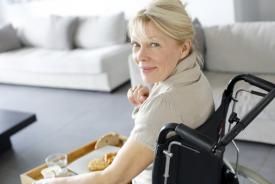

When Dr. Jeffery Brenner discovered the unlucky person who ended up in the hospital 131 times in a single year, he was able to secure funding from Robert Wood Johnson to focus on the 80% of health outcome factors not being addressed. Oregon Governor John Kitzhaber, a former emergency room physician, negotiated a $1.8B deal with the U.S. Government to transform his Medicaid population into “coordinated care organizations” to begin addressing the other 80% of health outcome factors.
Governor Kitzhaber often tells the story of a 90-year old women with well managed heart failure who lives in an apartment without air conditioning. “Under the current system, Medicare will pay for the ambulance and $50,000 to stabilze her. It will not pay for a $200 air conditioner, which is all she needs to stay in her home and out of the hospital.” For 35-year old Oregon resident Jeremie Seals, this meant new boots, a pillow and a sleeping bag to help to keep him out of hospital after 15 visits for heart failure.
The new emerging reimbursement models will force providers to understand the other 80% of health outcome factors outside clinical care. The new reimbursement models include a single episode payment that includes the hospital stay and all services within 90 days and population models that pay for all of a person’s care over 365 days.
Clinical care will begin to evolve from “the service” of treating conditions to addressing the entire patient to ensure the desired health outcome. The approach will be to determine how to get the patient recovered or into a chronic stable state. A patient-centric approach will address each of the factors with clear recovery goals, a tailored recovery plan and use technology to monitor each of the following 24 hours per day:
Clinical Condition – Chronic conditions such as asthma, COPD, cancer, diabetes, heart disease and HIV/AIDS. What are the physiological metrics (heart rate, blood pressure)? Is the wound healing? Is pain increasing or subsiding? The treatment of these conditions is not always tailored based on the other 80% of health outcome factors. We will soon have 141,000 codes (ICD-10 in 2014) to describe a clinical condition to determine billing for “the services”, yet we lack a recovery protocol that takes into account the thousands of factors in health outcomes.
Functional Condition – Can they go to the store and cook fresh healthy food or do they eat mostly unhealthy packaged food? Can they experience the outdoors or pursue their passion, or are they homebound? Can they be with those they love or feel a sense of purpose in other people’s life?
Patient Activation – Does the person understand their condition and treatment? Do they know how to take care of their condition? Do they have their follow-up physician appointment scheduled? Are they adhering to their prescribed medicine or therapy? Do they maintain the ideal activity levels?
Socioeconomic Status – Does the chronically ill person need to decide between food and medicine? Does the patient need the $100,000 proton beam radiation cancer treatment with the $20K copayment when there is no comparative effective research that it’s better than the $20K alternative? Is the person in a nursing home because they couldn’t afford the out-of-pocket cost of home care?
Physical Environment/Setting –Are there throw rugs in homes of people recovering from hip or knee replacements? Is there mold in the home of someone suffering from Asthma or COPD? Does their long term care facility have the resources that match the patient’s needs? CareMore Medical Group addressed this in 2008 when they installed $500 air conditioners in patient’s home in the advance of a heat wave to keep patients out of the hospital.
Care Team – Is there a care team of physicians, therapists, nurses, pharmacist, recovery coaches, patient navigators, care givers, family and friends all in sync and communicating? Do they have a care giver to help them feel connected and loved as well as drive them to doctor visits? Health Affairs found if states increased by 1% the number of elderly who got meals delivered to their homes, it would prevent 1,722 people on Medicaid from needing nursing home care.
In order to fully recover or bring stability to chronic conditions, there needs to be a laser like focus the entire patient. The new science, technology and reimbursement models will enable this to happen in a way that is just now becoming feasible. It will help to create the healthcare we want.
(Non-clinical factors / shutterstock)